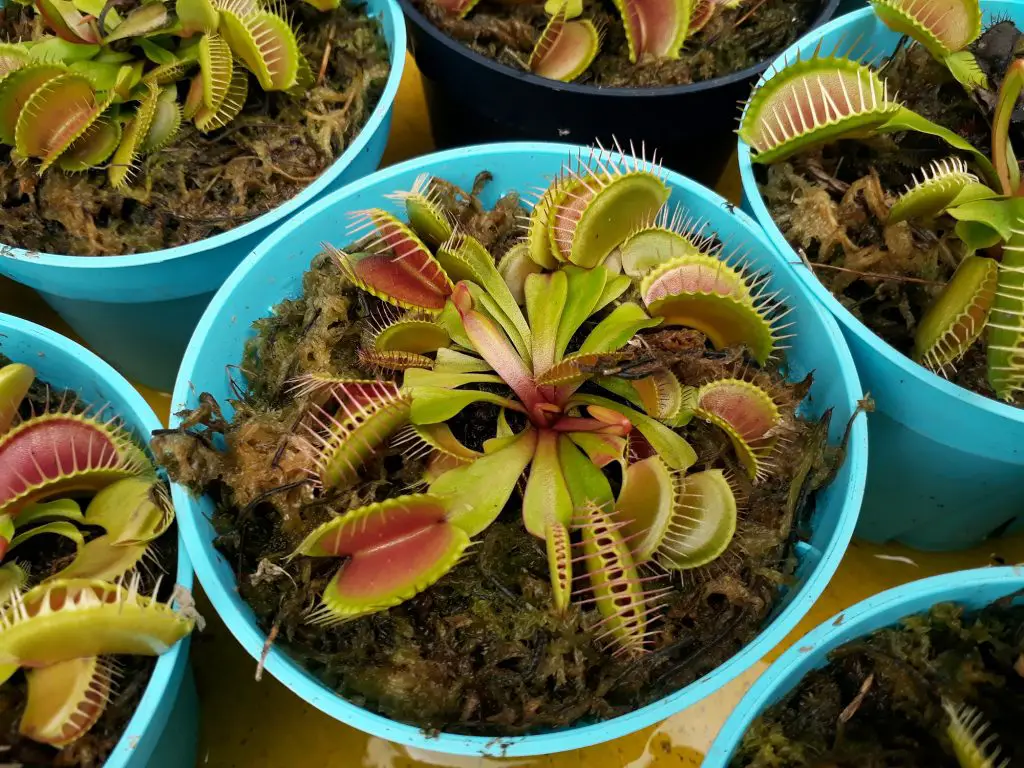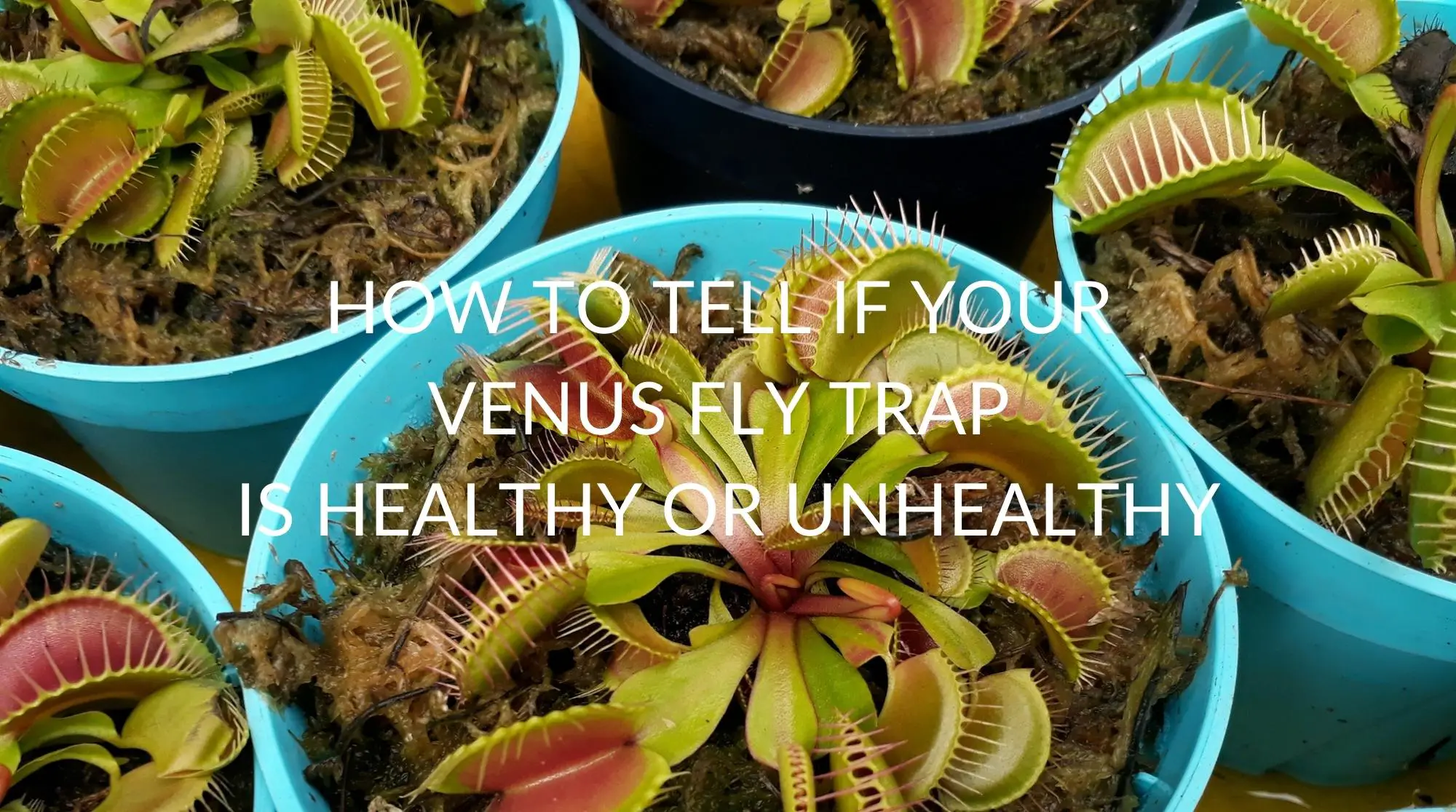You can assess the health of your Venus flytrap by checking the color and brightness of the plant, the clearness of the plant’s surface, and the response of its little green “traps” to stimulation by insects.
This article takes a look at how to evaluate the health of Venus flytrap plants: what kind of symptoms to look for, how you can fix them, and finally, how to avoid damaging your plant’s health in the first place.
How Do I Know If My Venus Flytrap Is Healthy?
Your Venus flytrap is healthy if its colors are clear, bright, and vivid, if its stems are upright and strong, if the plant is not over blemished, and if your plant’s “traps” are able to snap closed firmly on insect prey.
If your Venus flytrap exhibits the following signs, it’s likely a healthy plant:
- Bright green stems and leaves
It’s ok if there are some pale green and white colors present too. Venus flytrap colors can alter a little when they are dormant anyway.
- Stems and leaves are fleshy but strong
There should be no signs of rot or stress to the stems, and the flesh of the plant should be plump and firm.
- The insides of the plant’s traps are bright red and/or maroon
It’s ok if there are also shades of cream, brown, and pink present. Different species of plants have slightly different colorings. However, a bright shade of red means the plant is receiving enough light.
- The number of brown or black blemishes is low
It is normal for a Venus flytrap to have some blemishes, but there should not be too many, and the blemishes should not be large.
- There are only a few black leaves at any one time
It is normal for the leaves to drop off as part of the natural life cycle. However, too many black leaves is a sign of poor health and/or stress.
- The traps are responsive to insects
The traps will close loosely at first and then tighten in response to the insect struggles against the trigger hairs. It will then digest the insect, a process that can take up to 12 days, depending on the size of the insect.

What Does An Unhealthy Venus Flytrap Look Like?
You can be sure that your Venus flytrap is not healthy if it is covered in blemishes, if the traps are unresponsive, if the insides of the traps are black and if the stems and leaves have turned white or yellow.
All of these symptoms mean your plant is struggling to survive, and there is a variety of reasons for this, so make sure you read on:
- Stems and leaves are yellow or browning
You will probably notice color changes fairly quickly because a healthy Venus flytrap is such a vivid and noticeable green. However, yellow and brown stems or leaves are a clear indication that your plant is no longer thriving.
- The normal red colouring (inside the traps) has begun to fade
This is a sign that your Venus flytrap is not getting enough light. Fortunately, this is one problem that is easy to fix.
- The inside of the traps has no red at all
This is a sign that your plant has not had enough light for quite some time. Because a Venus flytrap relies on photosynthesis for food, it will abandon all other methods (such as catching insects) and focus only on “catching” light when it is light-starved.
To do this, it will use a kind of self-defense mechanism and grow completely green leaves without any red color inside the traps.
- A large number of black leaves
A small number of black leaves is normal, but a large number means there is a problem with plant food or that the plant traps are suffering some kind of mechanical stress.
- A number of black leaves and a change in the appearance of your plant
Significant changes occurring together indicate that growing conditions are less than optimal.
- There is red colouring at the base of the leaves
This is a type of sunburn and indicates heat stress.
- There are black spots in the root bulb of your plant
Black spots are a sign of rot. It’s time to repot the plant using different soil.
- The root bulb has a soft pulpy texture
A change in the texture of the root bulb indicates poor soil, wrong soil, or overwatering.
- The plant smells unpleasant
An unpleasant odor occurs when your Venus flytrap has been overwatered, and rot occurs at the root level.
- The leaves have a withered, tired appearance and no longer close when stimulated
Venus flytrap leaves only last so long, and they will only open and close so many times before they die. Overstimulating the leaves will hasten their death.
This is a common occurrence with Venus flytraps because curious owners (and onlookers) stimulate the plant so they can watch the ‘eating’ process close up.
What Does A Healthy Venus Flytrap Do?
A healthy colorful Venus flytrap will sit tight and upright, and the traps will lie displayed with lobes open. The hairs inside each trap will display straight and intact.
The traps will close in response to stimulation from unwary insects. Once closed, the outside of the lobes remain supple and green and will eventually open on their own.
There is no need to ever help a Venus flytrap reopen its lobes. Doing so will cause damage to the hairs inside the traps.
A healthy plant may produce a shoot from its middle. This will normally bud into a flower. Some growers will remove this shoot if they want their plant to grow larger and with more lobes instead.
However, if you’d like to see your Venus flytrap in flower, then leave the shoot intact.
Why Causes A Venus Flytrap To Become Unhealthy?
A healthy Venus flytrap will slowly begin to deteriorate for a range of reasons, but which all relate back to growing conditions.
- The plant is living in bad soil
Unfortunately, normal potting soil can kill a Venus flytrap. Although it may seem strange, Venus flytrap plants need mineral-free and nutrient-free soil to survive.
- The plant is receiving the wrong type of water
Again, Venus flytraps cannot survive if they are watered with normal water. Distilled water or rainwater is best.
- Not enough water
Venus flytraps thrive in humid environments. It’s best to keep the soil moist at all times.
- The plant is not receiving enough light
Venus flytraps will literally starve if they don’t receive enough light. They will first lose the red coloring inside the traps. They will then weaken and finally die. Your plant needs at least 6 hours of direct sunlight each day.
- The plant is being overwatered
This is a common problem because we tend to associate Venus flytraps with humid environments. However, although your plant needs its soil kept moist, it should not be soaked.
- The plant is being injured
Unfortunately, Venus flytraps are prone to mechanical injuries because of the human fascination with the “traps.” Constantly stimulating your plant to “eat” will exhaust it. Trying to motivate it to eat human foods will cause the traps to rot (along with the food caught inside them).
- The plant is suffering heat stress
Although your Venus flytrap loves light, it does not love the heat. Leaving your plant exposed to high temperatures will cause a type of sunburn. You’ll notice a red discoloration at the base of the leaves.
- General stress
Venus flytrap experts say that these plants can suffer from general stress caused by moving them around too much or by continually setting off the traps for no reason.
Curious onlookers can cause this, but it can also happen if you place your plant in front of moving curtains, for example, or within reach of boisterous pets!
How Do You Keep a Venus Flytrap Healthy?
Keeping your plant healthy means keeping its pot conditions correct and finding it somewhere to live which is sheltered and light (but not too hot).
Remember, too, that flytraps are not toys. They are extraordinarily delicate and complex plants and do not cope well with giving constant demonstrations.
Venus flytraps employ significant quantities of energy, activating the trapping mechanism. If you use them for no reason, your plant will continue to lose energy. Eventually, the traps will die.
Make sure your plant does have access to insect food. It is easy to place the plant outside to make sure it receives the correct amount of sunlight – but it may not receive enough insect life. Manually feed your plant one bug at a time. Wait around 3 weeks for the next feeding.
Don’t be tempted to choose a huge bug. The lobes won’t be able to close and so won’t digest the food.
Avoid overfeeding your plant. Too much food will cause rot and stress to your plant.
Check for pests such as mites or aphids. Venus flytraps are as susceptible to these as any plant. Always use a spray that is suitable for Venus flytraps.
What Does A Venus Flytrap Look Like When It’s Dying?
A dying Venus flytrap will appear pale, limp, injured, discolored, and/or may produce a rotting smell from the soil in the pot.
The plant will display all (or most) of its leaves blackened, and they will have a soft watery texture rather than feeling plump and full.
Other details you will notice include:
- There has been no growth in the plant for some time
- Stems and leaves dropping and/or falling off the plant
- Rotten plant matter at the base of the stem
- The bulb has gone soft and mushy
- The bulb smells rotten
- All of the traps are black
Can You Save A Venus Flytrap That Is Dying?
It is possible to rescue a dying Venus flytrap and rehabilitate it completely. You just need to get to the plant before it dies completely. The first thing to do is try and work out why your plant is sick in the first place.
If you aren’t sure what’s causing the problem, follow the following list carefully, making sure that each point can be checked.
- Are you using the correct potting soil for Venus flytraps? If not, change it immediately. The best soil is made up of half sand and half peat moss.
- Is your plant light starved? Move it so it receives from 6 to 10 hours of direct light per day.
- Are you using the correct water? Make sure you are only using either distilled water or rain water. Avoid soaking the pot and causing the bulb to soften and rot.
- Are you keeping the plant constantly moist (but not soaked). The plant should be kept in a slightly humid atmosphere.
- Are you feeding your plant correctly? Remember, you really only need to feed your plant with insects if it is kept indoors. Feed it with insects or arachnids only, and never give it small pieces of human food. This causes the traps to rot and turn black.
- Check for diseases and pests. Venus flytraps are vulnerable to aphids and fungal diseases, all of which can be treated.
- Is the plant trying to flower? If so, remove the flowering stem so the plant can apply its energy to recovering.
Recap
Keeping your Venus flytrap healthy is important because it tends to stop thriving suddenly and can die quickly if conditions are unfavorable and not immediately rectified. The best way to check on your plant’s health is to examine its color, texture, stem and leaf surface, and the smell near the plant root.
If you notice any issues, reassess your plant’s living conditions and location, your watering schedule, and the amount of food the plant has access to – and remember this includes access to light.

